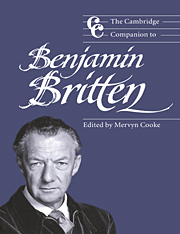Book contents
- Frontmatter
- Introduction
- Part one Apprenticeship
- 1 Juvenilia (1922–1932)
- 2 Britten, Auden and ‘otherness’
- 3 Britten in the cinema: Coal Face
- Part two The operas
- 4 ‘He descended into Hell’: Peter Grimes, Ellen Orford and salvation denied
- 5 The chamber operas
- 6 Gloriana: Britten's ‘slighted child’
- 7 Britten and Shakespeare: A Midsummer Night's Dream
- 8 Eros in life and death: Billy Budd and Death in Venice
- Part three Perspectives
- Part four The composer in the community
- Notes
- Index of Britten's works
- General index
5 - The chamber operas
from Part two - The operas
Published online by Cambridge University Press: 28 September 2011
- Frontmatter
- Introduction
- Part one Apprenticeship
- 1 Juvenilia (1922–1932)
- 2 Britten, Auden and ‘otherness’
- 3 Britten in the cinema: Coal Face
- Part two The operas
- 4 ‘He descended into Hell’: Peter Grimes, Ellen Orford and salvation denied
- 5 The chamber operas
- 6 Gloriana: Britten's ‘slighted child’
- 7 Britten and Shakespeare: A Midsummer Night's Dream
- 8 Eros in life and death: Billy Budd and Death in Venice
- Part three Perspectives
- Part four The composer in the community
- Notes
- Index of Britten's works
- General index
Summary
The success of Peter Grimes owes much to Britten's convincing use of substantial forces; his creation of appropriately powerful and imposing textures for the depiction of sea, storm and the social menace of a crowd bent on vengeance and retribution. Grimes is grand opera after the model of Verdi, Puccini, Berg and Gershwin, a genre which aimed to hold and persuade a substantial audience in a large theatre. Yet this was not how opera, music drama, had first been conceived, and by the middle of the twentieth century it seemed clear to many composers that the romantic and late-romantic eras had explored only one of the ways in which music and drama might interact.
Britten's interest in such precedents for a more intimate kind of music theatre as Dido and Aeneas and The Beggar's Opera would have been sharpened by his regard for twentieth-century compositions like Holst's Sāvitri (three singers, at most twelve players in the orchestra) and various works by Stravinsky (Renard, The Soldier's Tale) which turned their backs on opera as traditionally conceived. In a manifesto of 1946 Britten put the point with characteristic directness: ‘I am keen to develop a new art-form (the chamber opera, or what you will) which will stand beside the grand opera as the quartet stands beside the orchestra. I hope to write many works for it.’ The impulse behind this ‘new art-form’ was nevertheless not purely aesthetic.
- Type
- Chapter
- Information
- The Cambridge Companion to Benjamin Britten , pp. 95 - 112Publisher: Cambridge University PressPrint publication year: 1999
- 1
- Cited by

